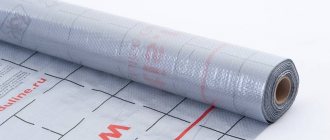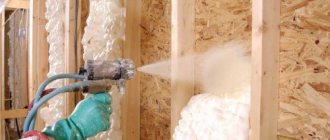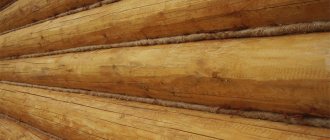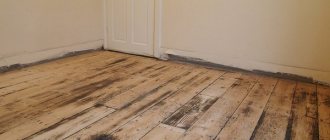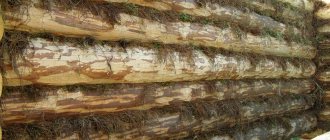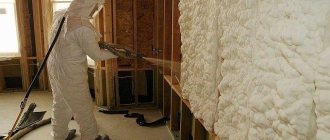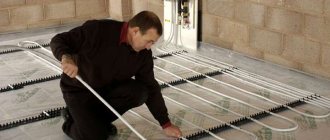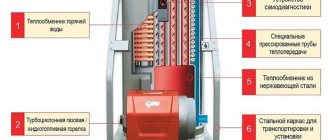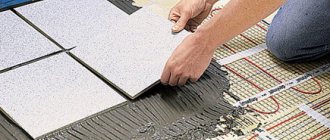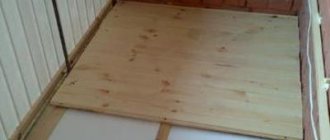Ceiling insulation material
AKTERM Standard
A universal material based on water dispersion, has thermal insulation and waterproofing properties, intended for industrial and domestic use with operating temperatures from –60°C to +150°C.
Universal liquid thermal insulation – insulation from the inside
More details
In one case or another, tiled mineral, polymer and other non-bulk materials can be chosen as insulation: mineral wool, penoplex, expanded polystyrene. Expanded clay, warm slag or sawdust are suitable for external thermal insulation. Each option has its own advantages and disadvantages, which should be taken into account when choosing a method for insulating the ceiling.
The insulation technology is largely determined by the specifics of the tasks being solved. If you need to insulate the roof of a house or arrange a living space in the attic, one option for thermal insulation of the ceiling is selected. It’s a different matter when it comes to insulating the floor itself, which acts as the ceiling of the building’s interior. There are also universal options that are equally suitable for any task in the field of ceiling insulation.
Liquid insulation materials, in particular heat-insulating paints, have become increasingly popular in recent years. Thermal paints represent the latest innovation in the field of thermal insulation products. Applying a 1 mm thick layer of such paint is similar in terms of thermal conductivity to insulating the ceiling using polystyrene foam with a layer 5 mm thick. This method of ceiling insulation demonstrates maximum efficiency while being economical. Painting products are easy to use, which makes it easy to cope with the task of performing ceiling insulation yourself, without involving specialists. It is enough to have a regular roller or brush at your disposal. A special spray gun is also suitable to ensure ease of work over a large area. Application of the material is carried out by analogy with conventional paint. It is enough just to pre-clean the surface and prepare it properly. The mixture adheres well to any type of surface and has better adhesion than traditional paint. During the day, polymerization of the material occurs. Upon completion of this process, an elastic coating is formed, creating the so-called “thermos effect”. This coating does not require any additional painting or surface finishing. The instructions supplied with the Akterm thermal paint will allow you to understand all the intricacies of applying the material. Coping with this task will not be difficult even for a person who is not knowledgeable in the construction field.
Liquid thermal insulation has a very wide range of applications, including thermal insulation of the ceiling. This type of surface insulation also provides excellent waterproofing properties to the surface and a renewed appearance. The treated surfaces look neat, and at the same time, the process of applying the material itself does not present any difficulties even for a non-specialist. It should be noted that modern thermally insulating painting materials are environmentally friendly products made from high-quality components. Thermal paints include a polymer matrix and filler in the form of hollow microspheres. Because of this, the material is completely non-toxic. Its compliance with all modern standards and requirements is confirmed by the availability of appropriate certificates.
Liquid thermal insulation has the form of a suspension based on acrylic structured polymers. Glass microcapsules with an inert gas inside act as a heat-insulating component. It is these hollow balls that make up most of the volume of ultra-thin thermal insulation coatings. The entire remaining volume is occupied by a binder in the form of a molecular “sieve” that retains water but allows air to pass through. This ensures excellent breathability of the coating. The basic principle of operation of thermal paint is to create a thermal barrier that reflects incident light rays. Due to this, the thermal insulation material copes with its task perfectly.
A thin layer of paint can be an excellent replacement for traditional insulation systems. Thermal insulation of the ceiling using Akterm liquid paint does not take away the height of the room, which is of particular importance in small rooms. The all-season nature of the work allows it to be carried out even at low temperatures. At the same time, the coating can be used in a wide temperature range without losing its qualities. The service life of such coating is very long and reaches 15 years or more. A heat-insulating material such as Akterm paint can solve other problems at the same time: freezing of walls, corners in the house, the formation of fungus and condensation. All this is successfully prevented through the use of modern thermal insulation material - thermal paint. In fact, such a painting material is a ready-made insulation system that does not require any modifications.
Choosing ceiling insulation Akterm ceiling is the most economical way to insulate your home in a productive and aesthetically attractive way. Proper organization of thermal insulation of the ceiling in the house will make living in it much more comfortable and cozy.
Any methods and materials are used for thermal insulation of ceiling panels. But the most technically accessible and reliable is the use of modern liquid insulating paints.
Floor insulation in a wooden house
The floor of a wooden house is a multi-layer structure, which includes rough and finishing floors. A thermal insulation layer is laid between them. Floor insulation in a wooden house is mainly carried out during the construction process.
The work is carried out in the following order:
- Roofing felt is laid on the subfloor.
- The roofing material layer is covered with sand (3-5 cm) and carefully leveled.
- Lay polyethylene film and secure it to the base with nails or a stapler.
- Penoplex is laid (insulation with low thermal conductivity, high acoustic absorption, and environmental friendliness).
- Lay chipboard.
- Install the finishing floor.
Violations made during the installation of thermal insulation provoke the formation of condensation on structures, which leads to the emergence and spread of mold and fungi. There are a number of requirements for the materials used. They must have:
- Low thermal conductivity even when exposed to moisture.
- High compressive strength.
- The degree of deformation tends to zero.
In addition, it is important:
- correct calculation of the thermal parameters of the building,
- competent project,
- qualifications of specialists performing the work.
Thermal insulation of the ceiling using Akterm paint
Akterm liquid insulator is a polymer suspension based on acrylics. The insulation contains organic tin oxide solvents and nanoparticles that form an inorganic adhesive bonding liquid - this provides complete protection from harmful ultraviolet rays and greatly reduces the transmission of infrared radiation. Individual properties, without compromising health and the environment, effectively protect the interior from overheating or cold.
"Akterm" is an ideal choice for modernization, as well as uneven surfaces due to glass microcapsules filled with inert gases. Insulating paints have a pronounced heat-reflecting effect, eliminate contact with water, cold air and return up to 70% of infrared radiation. The advantages are obvious:
- The thinnest layers do not support combustion and slow down the spread of smoke;
- Non-toxic, environmentally friendly, resistant to fire and ultraviolet radiation;
- They are distinguished by lightness and flexibility;
- Reduce heat transfer and reliably bond to the base material, including on non-standard surfaces;
- Eliminates condensation without risk of rust formation.
“Akterm” is the thinnest insulating liquid of a new generation, which is easy to apply without special training using flat brushes, paint rollers or spray. Insulating paint can be used to insulate ceiling structures or limit extraneous sounds.
"Akterm" is a liquid, elastomeric and continuous waterproofing that is installed in a single layer with excellent adhesion to all types of surfaces. The structure can be concrete, gypsum, wood, or plasterboard.
Preparation consists of cleaning from decorative coatings, oil stains, drying, if necessary, forced drying. Particular attention should be paid to freezing, which is recommended to be eliminated only when dry.
- If the ceiling shows signs of mold infestation, it is recommended to first dry it and disinfect it with a fungicide.
- Subject to preliminary priming, Akterm should be used only after the primer has completely dried.
- It is not recommended to use the insulator on a wet or icy surface.
- The paint in the container must be stirred periodically to prevent thickening during work.
- To determine the quality of the work done, it is worth inspecting the coating - the base should be evenly covered with an insulator.
- The protective layers form a solid, homogeneous layer without gaps, stains or dents. Drying time depends on temperature conditions.
- If paint, varnish or other liquid finishing coatings must be applied directly to insulation, water-based materials are required.
The dried insulating paint becomes a single, smooth membrane. It is difficult to find more reliable protection from condensation and flooding, from extraneous sounds and echoes. At the same time, the insulation becomes a flawless decorative finish. The economic component in the use of liquid insulation is not the least important - independent use and affordable cost save money, time and useful space.
“Akterm” maintains a comfortable mode and provides a “green home” with effective health protection products.
Thermal insulation of the ceiling may be necessary for both apartments and country houses. The task of thermal insulation is to maintain an optimal, comfortable temperature in the room through the installation of additional materials.
Reliable thermal insulation will help protect the room from heat loss and help save heating costs. The choice of material depends on many factors - the purpose of the room, the financial capabilities of the owners, and the design features of the room.
Fiber insulation
A group of heat-insulating materials consisting of the finest fibers is widely used for insulation.
A group of heat-insulating materials consisting of the finest fibers is widely used for insulation. This includes glass wool and mineral wool of various origins. For use in residential premises, only basalt or fiberglass mats can be used. They are more environmentally friendly and will not harm people's health. Cotton wool made from industrial slag is often toxic.
The advantage of fibrous materials is their lightness, softness, and easy installation. Basalt wool can withstand heating up to 1000 ºС without flaming. She does not like mold, rot, mice and bugs. The mats can be installed in two layers; thanks to the fibrous structure, the joints are quite dense without additional insulation.
But we cannot say that these are the best insulation materials for ceilings. They have a number of serious disadvantages:
- Sensitivity to moisture. Any cotton wool absorbs moisture well. When wet, such insulation will become unusable.
- Loss of shape during use. Even small static loads (including gravity) cause mats to stick. The smaller the volume of cotton wool, the less air it contains, and the worse its thermal insulation properties.
- Working with glass wool is impossible without personal protective equipment. Gloves, goggles, and thick clothing are required. Glass chips are very scratchy and cause a lot of discomfort.
Thermal insulation of the ceiling with fibrous materials will be effective, but not durable. If you don’t want to redo the work every 2-5 years, you should consider other options.
Polyurethane foam from Ecotermix has many useful properties, which are discussed in the video below:
Principles for choosing a heat insulator:
- The material must be resistant to fire and high temperatures;
- It is worth choosing an insulator that is characterized by low weight;
- It is necessary to choose environmentally friendly materials;
- It is important to consider the level of humidity in the room and choose a material with a certain level of hydrophobicity;
- The material must be certified - you should not save money by using an inexpensive, dubious heat insulator;
- Pay attention to the level of vapor permeability.
To insulate the ceiling you can use:
- Polystyrene foam is an inorganic material that is characterized by density, low weight, high protective performance, and ease of installation.
- Expanded clay is a means for insulation, characterized by resistance to fire, protects against heat loss, and has good sound insulation properties.
- Mineral stone wool is a popular product used for insulation. Requires a professional approach to installation. Well protects from the cold. It is quite expensive.
- Cellulose insulation or ecowool - suitable for insulating hard-to-reach places. The material has the advantage of being environmentally friendly - it is absolutely safe for the residents of the house.
Stages of insulation
The process of insulating a country house consists of a number of stages:
- foundation insulation,
- floor insulation,
- wall insulation (internal and external),
- ceiling insulation,
- roof insulation.
Below in the article we will look at some of these stages in detail.
In order to achieve the maximum effect from the insulation, the house should be insulated comprehensively. It is very important to use only high-quality materials.
Isn't it easier to buy heat-insulating paint?
The ceiling is often simply painted white. Then why not take white insulating paint? First, it forms an excellent heat-reflective coating that will keep the heat from escaping from your room. Secondly, if you use heat-insulating paint and buy it of the proper quality, then thanks to its polymer structure it will lay well, in a thin layer, and therefore will look just great. Thus, warm air, which always rushes upward, will not give off its heat through the ceiling into the cold attic. This will simplify the operation of the batteries, because heat will not be lost through the ceiling during air convection. This means you will save more energy heating your boiler. And if you have a stove in your house, it will “ask” for less wood or coal.
Spray polyurethane foam
Today, sprayed polyurethane foam is considered the best insulation for ceilings.
This material is worth discussing separately. Today, sprayed polyurethane foam is considered the best insulation for ceilings. The unique application technology allows you to create lightweight, strong and durable thermal insulation on both wooden and reinforced concrete floors. Consumers choose polyurethane foam for several reasons:
- High application speed. Ceiling insulation work is completed within one working day.
- Excellent noise, steam and heat insulation qualities. There is no need to install additional vapor barrier.
- Ability to process complex structures. When applied to the ceiling from the attic side, polyurethane foam allows you to isolate the intersections and connections of building structures, and hard-to-reach areas under the joists.
- Self-extinguishing ability. The polymer does not ignite when exposed to extreme heat and can only burn in the presence of an open flame. When removed from the flame, polyurethane foam extinguishes and does not smolder.
- Eco-friendly. The material does not contain harmful additives and does not emit toxic compounds during operation.
- Durability. Sprayed thermal insulation retains its properties for 30-70 years.
There are many thermal insulation materials on the market. The owner must decide which is better. There is no point in saving on ceiling insulation in a private home; any mistake always has unpleasant consequences.
We recommend watching a video about ceiling insulation with PPU from Ecotermix to have an idea of how this happens and why PPU is considered the best among other insulation materials
Why should the price of liquid thermal insulation be high?
Firstly, thermal insulation in the form of paint, used in housing construction and public utilities, can be classified as an innovative product. Secondly, liquid thermal insulation, the price of which cannot be compared with the cost of conventional paint, is a high-tech product. Both of these points indicate that such paint cannot be cheap. After all, it performs a more complex task - it reflects heat, and it does it so effectively that when it paints hot boiling water tanks, people don’t get burned by them, they just feel that these tanks are warm.
